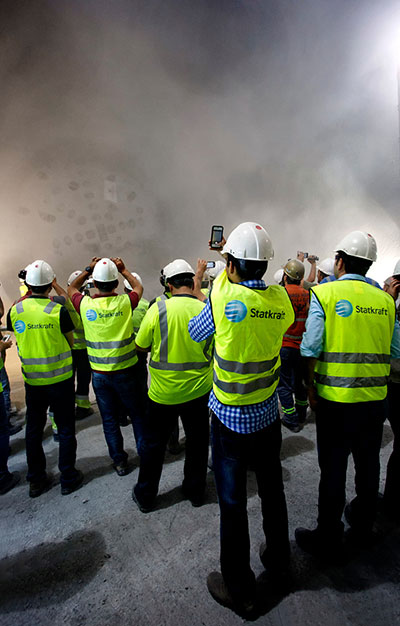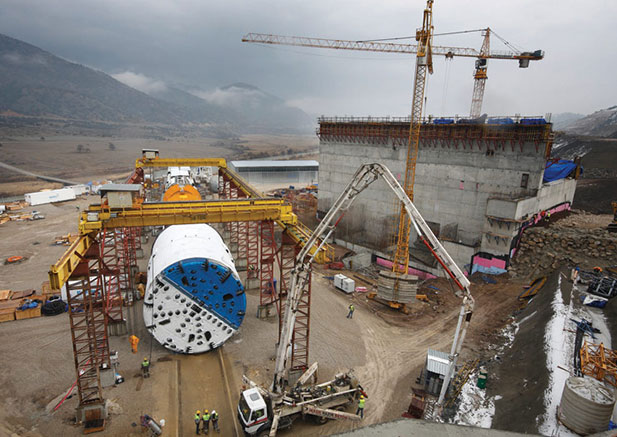Flexibility key to battling poor geology in Turkey 23 July 2014
It is the nature of tunnelling that the tunnel is always finished – eventually. But almost from the first turn of the cutterhead on the 10m diameter Robbins double shield machine selected for excavation of 11.8km of headrace tunnel on the Kargi Kizilirmak Hydroelectric Project, it became evident to both the contractor and the machine manufacturer that geology along the alignment would be much worse than predicted.
Completion of tunnelling following breakthrough of the TBM on July 5 (2014) has been all the sweeter for this, despite coming six months behind the originally scheduled completion date, though within a rescheduled extension agreed between contractor Gülermak of Turkey, and the client, Statkraft.
Major machine modifications, extensive hand-mining of bypass tunnels to repeatedly free the TBM from collapsed ground during the very early days of the drive, a complete change of tunnelling strategy in mid-drive, alongside sheer determination to get the job done, all proved necessary to get a tough task back on track.
“Both Robbins and Gülermak gained valuable experience here in the difficult geology,” said Yunus Alpagut, the Country Representative of Robbins in Turkey and one of the members of the team. “It has been a good lesson for tunnelling in such conditions. The important thing here has been that if all parties click – the contractor, the client and the TBM manufacturer – everything goes well, but if there is a discrepancy there is a headache: this we learned."
Things started to go wrong at the start of the drive in April 2012, when after the first 80m of progress the machine became stuck in a section of collapsed ground. This required the first of an eventual six hand-mined bypass tunnels in the first 2,000m of the drive. With conditions alternating between solid rock and running ground, the machine stalled on a number of occasions and by Spring 2013 barely 2,800m had been excavated.
“At the start it was foreseen that the first 2.5km would be mixed ground conditions of self-supported but fractured rock. After 80m, and with the backup still mostly outside the tunnel, the TBM hit an unexpected fault line,” said Alpagut. “It was blocky rock in clay and sand, and it was difficult to control the TBM. It was thought afterwards that this was just bad luck and so the team continued in the same manner. But in the coming six months five more bypass tunnels would be needed because of running ground, squeezing ground, and in the worst cases, the cutterhead was coming up against a mixed face of half solid rock and half soil, sand and water. This caused delay and forced some major modifications to the machine.”
Chief among the modifications was installation of reducers to give a two-speed gearbox, thus enabling normal speed rotation of the cutterhead at 7 rpm for rock sections, but with the capacity to switch to a kind of EPB mode by reducing cutterhead rotation, increasing torque, and converting to single shield mode to pass successfully through sections of loose or squeezing ground. “We would advance in this configuration for several metres, before reverting back to normal double shield mode. There were many such interruptions for switching over to handle soft soils,” said Alpagut.
Lining redesign
In the face of such variable ground conditions came a decision, mid-drive, to change the specification of the primary lining.
Initially the lining of the TBM tunnel was divided into two methods. First a precast segmental lining in rings 400mm thick for an o.d. of 9.5m and in a 6+1 configuration for the first 2.5km of the TBM heading through anticipated mixed conditions; and rockbolting and shotcreting support for the remaining 9.3km through more competent conditions. In the event it was decided to install the segmental lining for the full length of the TBM-mined tunnel. This was a decision that caused further delays when the segment production facility, situated 2km from the portal, could not keep up with the higher advance rates that would be achieved during the second year of the TBM drive, when speeds ramped up through more favourable conditions.
According to Alpagut, problems associated with the curing of the cast segments were largely to blame.
“This was a huge change to the project, especially cost-wise, but there always seemed to be sections where the ground was fractured or loose,” said Alpagut. “Excavation here is very close to the North Anatolian fault line in Turkey’s predominantly fresh geology. There were a lot of small and wide faults along the alignment, and although this had been expected, their occurrence was far more frequent than had been predicted.” Site investigation boreholes were limited along the alignment that runs under a maximum overburden of some 600m and an average cover of about 200m.
To maintain progress a second major modification was made to the TBM. A custom-built canopy drill and positioner was engineered and installed on the machine by Robbins to allow pipearch pre-support through the forward shield. Drilled to a distance of up to 10m ahead of the cutterhead, 90mm diameter pipe tubes provided extra support across the 120-140° degrees of the tunnel crown. Injection of resins and grouting through the injection pipes protected against collapse at the crown while excavating through soft ground.
“After these modifications it is fair to say that there was no need for construction of any further bypass tunnels,” said Alpagut, and the drive progressed more smoothly. Successful use of probe drilling techniques, especially during regular stops for maintenance, proved “very helpful” in detecting loose soil seams and fractured rock ahead of the face. In fact, Gülermak measured cavity heights above the cutterhead in some fault zones at more than 30m.
But the slow progress of the first 2,800m – each bypass tunnel taking an average 14 days to construct followed by up to three further weeks for maintenance and cleaning of the machine and cutterhead – ultimately forced the second of two major project changes. A decision by the owner, in conjunction with Robbins and the contractor, converted excavation of the last 4km of alignment to drill+blast advancing from the tunnel’s opposite portal and constructing a cavern under the hills into which the TBM would break through. This effectively cut the length of the TBM drive, mid-drive, from 11.8km to 7.8km, and enabled progress on a reverse heading while simultaneously coping with the many challenges at the opposite end of the tunnel. “Stable rock conditions at the other end of the alignment were favourable for NATM excavation,” said Alpagut, although problems with water ingress were encountered along both headings.
The struggles of the first 2,800m of TBM advance however, were not to be repeated, largely as a result of the greater experience levels gained, and the successful application of the modifications made to the TBM. In March 2013 a monthly advance of 600m was achieved, while in April this year (2014), a project-best of some 723m was delivered in a month that included the daily best of 39.6m.
“This has been the toughest job in my tunnelling career,” said Alpagut, “and it is a testament to the skill and dedication of the Robbins team and the Gülermak contractor team that it has ended successfully.” Following assembly of the machine using the on-site first-time assembly method (OFTA), the Robbins field service team was cut to four personnel, headed by Glen Maynard. This was cut to two after the worst of the conditions thrown at the team was over, and since the beginning of the year the contractor’s team was judged to have gained enough experience to man the drive independently.
Once complete, the Kargi Kizilirmak Hydroelectric Project will generate 470 GWh annually. The 11.8 km tunnel will source water from the Corum River in central Turkey and convey it to a new generating station operated by owner Statkraft AS of Norway.
References
- Double shield taking on tough work in Turkey – TunnelTalk, August 2012
|
|
|
|
|
Add your comment
- Thank you for taking the time to share your thoughts and comments. You share in the wider tunnelling community, so please keep your comments smart and civil. Don't attack other readers personally, and keep your language professional.








